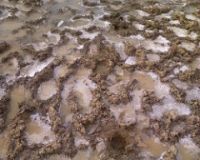How To Improve Heavy Clay Soil
Heavy clay soil can be difficult to work with but many wonderful gardens have still been created in areas of heavy clay soil. The key to successful gardening on heavy clay is to be aware of the problems and limitations of that soil type and to work to improve the shortcomings, while enjoying and maximising the benefits. Finding the right plant for the right place is also key to gardening success – a plant at home on a drought-ridden plain, for example, is unlikely to thrive in heavy clay that is prone to waterlogging. The pH of your soil is also something to consider. Beginning with the fundamentals, here are just a few things you should do to gradually improve heavy clay soil over time:
 Add Organic Material
Add Organic Material
Adding organic material should, without a doubt, be the number one priority for most gardeners, especially those with a heavy clay soil. Rather than digging organic material into the soil, you can simply add organic material, in the form of compost and mulches, on top of your soil. Worms and other soil organisms left to their own devices can then work together as a fully functioning ecosystem to incorporate the matter and nutrients into the topsoil below. Heavy clay will become wet and cold in winter and can bake hard and crack in the summer. Increasing the amount of organic material in the soil will allow heavy clay soils to drain more easily and mulches can help to protect the soil surface in summer and prevent it from drying out and cracking.
Avoid Compaction
 Clay soils, with their small particles, can be prone to becoming compacted. Organic materials will help lessen this problem but still, heavy clay soils should be treated gently. Try not to step on or compact your clay soil, especially if it is wet and cold. Treating clay soil gently will help it to retain a more aerated structure and retain its excellent fertility.
Clay soils, with their small particles, can be prone to becoming compacted. Organic materials will help lessen this problem but still, heavy clay soils should be treated gently. Try not to step on or compact your clay soil, especially if it is wet and cold. Treating clay soil gently will help it to retain a more aerated structure and retain its excellent fertility.
 Protect Over Winter
Protect Over Winter
Winter can be a difficult time for clay soils as they can easily become waterlogged or compacted. To protect clay soils in winter, it is a good idea to sow a cover crop in autumn. Nature abhors bare soil and leaving soil bare can manage fragile top soil and lead to the leaching of valuable nutrients. With heavy clay soil especially, it is a good idea to sow cover crops/ 'green manures' that will remain in place over winter and dug in to provide more organic matter when the spring arrives.
 Manage Water and Improve Drainage
Manage Water and Improve Drainage
Managing water effectively is very important in a heavy clay garden. To help reduce waterlogging, it is a good idea to plant thirsty trees, deep rooted plants such as comfrey to open up channels down through the subsoil and more plants in general to use water. Plants with strong roots will also help to break up and aerate heavy clay soil. If waterlogging is a severe problem in a heavy clay garden in winter then as well as devising a more appropriate planting scheme, it may also be a good idea to create raised beds in particularly bad sections, or to consider drainage schemes such as gravel ditches/ simple French drains to move water. Rather than moving water entirely off site, consider storing it in the ground and in ponds for use in dry weather later in the year. Clay's ability to retain water can be a benefit as well as a down side to this type of soil.